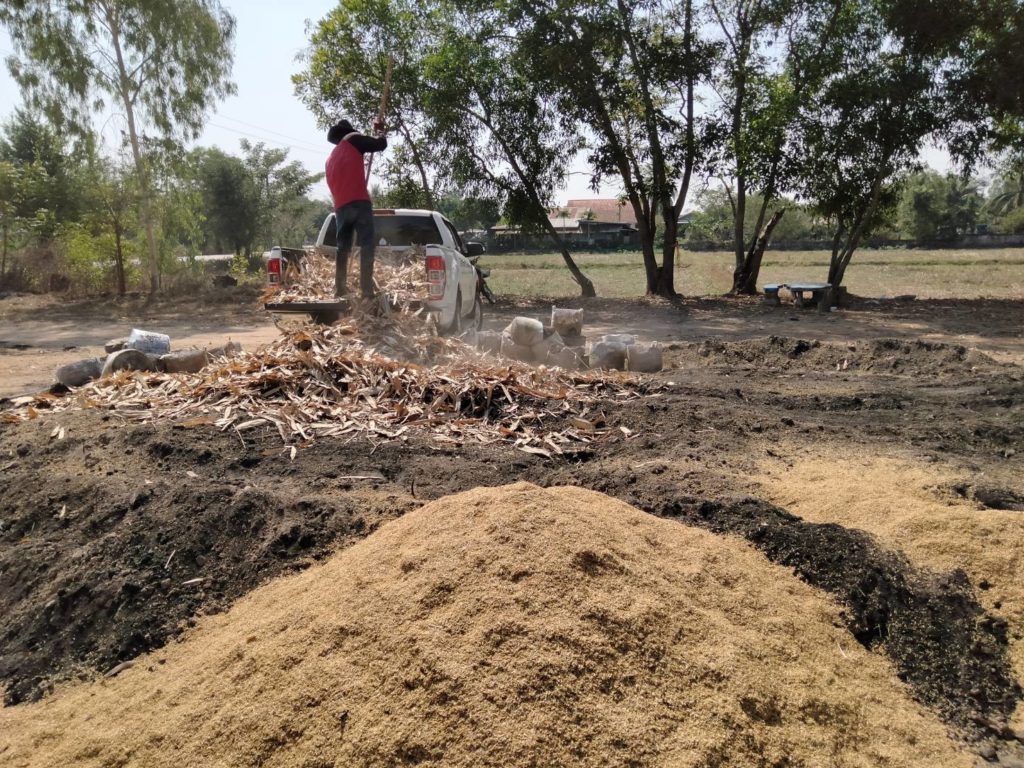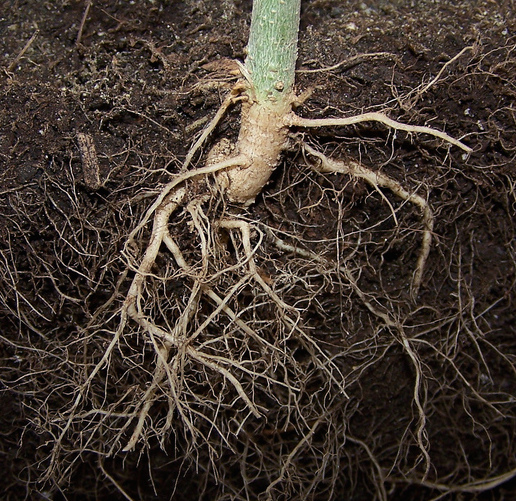This is hopefully enough for 1500 Bags. Azomite, Trichoderma, Mycorrhiza stuff, Carbonized Rice Hulls, Rice Hulls, Seaweed Extract, Bamboo Leaves/Compost, Worm Castings, Carabao Droppings, Bat Guano and other stuff. There is one other Pile. Yes it is a bit “over done”. Yet the Plants will gather what they need and I am sure it will be there for them. I do hope these two piles provide enough Soil for 1500 Sacks. The Amounts of each “Ingredient” added differ…
For the 1st few weeks mix it a few times then let the Pile “Cook. Mixing your dirt to much is not so good. Besides it will be mixed up again when you bag it up!

Adding Worm castings is very important. Humic Acid is prevalent in worm castings and this Soil will sit covered for several weeks before it is bagged and used. I recommend at least a Month prior to using the new soil. We mix it once a week, adding water as needed. Red Wigglers (Eisenia Fetida) will be obtained from my Friend in Surin and added when the Bagging occurs. If you need Bat Guano or Worms let us know!
Benefits of Using Worm Castings
Time-Delayed Release of Nutrients
When the worms leave their castings behind, the nutrients are bound in these castings. The castings are encased in a mucus membrane that takes time to dissolve. Think of it like a bubble that slowly gets thinner over time.
Because of this membrane, the nutrients are released slower and won’t burn the plant as some other fertilizers will.
Lots of Beneficial Microorganisms
Just like your digestive system, an earthworm’s digestive system contains a wide variety of microorganisms, enzymes, and hormones. All of these substances aid in the breakdown of the organic matter as it passes through the worm’s gut. As the final product leaves the worm’s body, so do some of these microorganisms that get passed into the soil.
Non-Toxic, Organic, 100% Natural, Odor Free
Does it get any more natural than using the worms given by mother nature? No, it doesn’t and the best part is, there isn’t an odor like regular manure.
Humic Acid
It sounds bad, almost like it could harm your plants, but that’s the furthest thing from the truth. Humic acid is a group of molecules that aid plant roots in the absorption of water and nutrients. It can be found in worm castings which helps to stimulate plant growth and nutrient uptake.
pH Neutral
If your soil isn’t exactly where it needs to be, worm castings can aid in stabilizing its pH level.




Growing Cannabis Plants In Soil
When you grow Cannabis plants in regular soil, you will need specific nutrients. Soil is different from hydroponic soil-less blends because it contains organic non-inert matter such as manure, worm castings, compost and humus. These contain a lot of micro-nutrients and macro-nutrients.
Lots of these substances’ nutrient value is insoluble, however, and therefore have to be processed by fungi and microbes living in the soil in order to be useful to the Cannabis plant. It is less common to see non-organic nutrients for growing Cannabis plants in soil since they build up rapidly in soil, causing damage to the soil-life and preventing nutrients and water from being taken into the roots.
Some Nutrients are Mobile (Transported Around your Plant), and some Nutrients are Immobile. If I see a Problem occurring due to an “Immobile” Nutrient. I will use Folic Acid and The Needed Nutrient and Spray (Foliary Feed) The Plants. Starting off from the Beginning of your Grow with a Proper Soil Mix helps avoid this scenario. Also a Thriving Rhizone will fix itself usually.

Rhizomes growing throughout the Rhizone

Technically, a Rhizome is a stem that grows underground. It usually grows horizontally, just below the soil’s surface. Since it’s a stem, it has nodes and is able to put out other stems, usually straight up and above ground. This means a patch of what looks like several individual plants grouped near each other may actually all be shoots of the same plant, put up by the same rhizome.
Rhizomes are also used by the plant to store energy, since they are thicker than above ground stems and under the soil where they are safe from freezing temperatures. Many cold weather perennials have rhizomes, and they use this energy storage to survive underground through the winter. Because they spread stealthily and are hard to kill, rhizomes can be the source of some serious weed problems.
Some plants will sprout from even a tiny fragment of Rhizome, meaning that eradicating certain weeds can be very difficult. By the same token, it can be very helpful if you’re looking for a lasting and spreading ground-cover in the garden.
On the other hand, Organic nutrients and Fertilizers for Cannabis plants are more commonly seen. These contain fewer nutrients which are immediately soluble together with elements which have benefits for organisms naturally in the soil. Therefore, if you’re going to grow your plants in soil, using organic nutrients and fertilizers is always advised. The Worms and Bacteria will be able to break these substances down and also using some in-organic substances can kill these beneficial Organisms.
There are a number of affordable organic fertilizers which you can use. These include fish and blood meal which offers plenty of nitrogen, bat guano and bone meal which supplies phosphorus, kelp meal and wood ash to supply potassium, Epsom salts which supply sulfur and magnesium, and dolomite lime which supplies magnesium and calcium. You can buy the majority of these in a garden center.
What Should You Know About Nutrients?

If you’re growing Cannabis for the first time, selecting the right nutrients for your plants can be a challenge. There are lots of options on the market, so how do you make the right decision?
The key to choosing nutrients lies in understanding precisely what Cannabis plants requirement and in being aware of how they absorb nutrients and utilize them. When you have this knowledge at your fingertips, you can make a confident decision about which products to buy without wasting your money.
What Do Cannabis Plants Need To Grow And Thrive?
Cannabis plants require a number of collective elements known as “macro-nutrients”. These include a number of mineral and non-mineral elements. Some come from the water, some from the air and some from the soil in which the plants are grown.
These nutrients come from the soil:
- – Phosphorus
- – Nitrogen
- – Calcium
- – Potassium
- – Sulfur
- – Magnesium
These nutrients come from the water and air:
- – Oxygen
- – Hydrogen
- – Carbon
When you buy fertilizers or nutrient solutions, you’ll see 3 numbers on the packaging. This will show the composition of potassium, phosphorus and nitrogen inside the product. The nitrogen content will be listed first, followed by the phosphorus content and finally the potassium content.
What About Micro-nutrients?
Cannabis plants also require Micro-nutrients. These are required in much smaller amounts. These minerals include:
- – Zinc
- – Manganese
- – Iron
- – Molybdenum
- – Cobalt
- – Chlorine
- – Boron
- – Silicon
- – Copper
Although Cannabis plants don’t need a lot of any of these elements, they’re still essential to the plant’s growth and overall health.
All you need to do is mix them into your soil before you pot your plants. When you do this properly, watering will be all that’s required, along with adding carbohydrates occasionally. Some soil blends can also be bought which contain the ideal mix of those ingredients for greater convenience.
Nutrients For Each Stage Of Growth
Every stage of the life of your Cannabis plants requires nutrients which are slightly different. During its seedling stage, your plant probably won’t need any extra nutrients if you’re growing in soil as long as that soil is rich. If you’re growing using an artificial medium, you might want to use seedling nutrition and root boosters.
In the vegetative phase, your plants will require high levels of potassium and nitrogen as well as a moderate amount of phosphorus.
When your plants reach their flowering stage, you’ll need to reduce the nitrogen levels drastically, but increase the amount of phosphorus and maintain the potassium level. When you choose a Bloom fertilizer, the nutrients will be perfectly balanced for this stage of growth.
Guarding Against Feeding Problems

When you’re growing Cannabis, caution is always recommended. If you use too many nutrients, you could damage your plants. Only add nutrients to the water every alternate watering and half the doses if you’re in any doubt.
If you notice any changes in your plant’s color or appearance, your plant is experiencing a feeding problem. Nutrient imbalances are signaled by yellowing and drooping leaves, leaves with irregular dimensions or shapes, burnt edges and brown spots.
If you adjust the nutrient balance and still experience a problem try flushing pure water through the soil for several days before starting again with a half dose of nutrient mix.
Getting The pH Balance Right

If the pH level is wrong, the plants can’t get the nutrients they need to grow and thrive, even if you add the right mix of nutrients to your water. Therefore, monitoring your pH levels is vital.
When you’re growing Cannabis plants for the first time, erring on the side of caution is always important. However, follow this advice and you should find that, as long as you use the right nutrients for the medium you are using, your plants meet all your expectations.
This time around we are going to use the Large Rice Sacs. We heated up some Rebar and stacked up 20-30 sacks and burned drainage holes in them. Saved around 16,000.00 Baht! This is a very Valuable thing the People of Thailand are and have Taught me. Saving Money!
Kevin Thailand Hemp Farms


